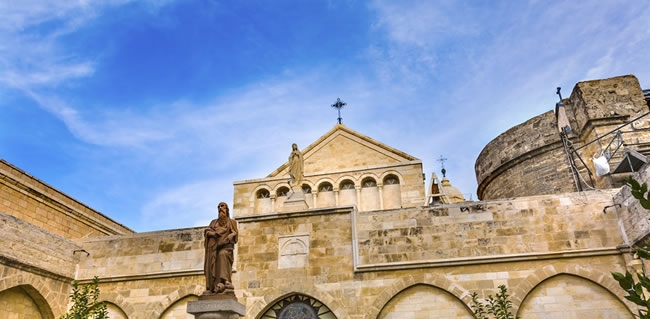The Church of Saint Catherine is a 19th- century Roman Catholic Church located adjacent to the Basilica of the Nativity in Bethlehem. The Chapel was built over the cave where Jesus was born, and it even shares a wall with the Basilica of Nativity.
Saint Catherine Church works both as a parish and a Franciscan monastery. Beneath the church there is also a cave complex. In 2012 UNESCO World Heritage listed it as the birthplace of Jesus: Church of the Nativity and the Pilgrimage Route, Bethlehem.
In 1347 the Chapel was dedicated to St. Catherine of Alexandria, and constructed in a modern Gothic theme, but has since been modernized over time. The Church however is most famous for the celebration of Midnight Mass on Christmas Eve. Here the celebration of Mass is televised to millions of viewers worldwide. The Church is also frequented and visited by groups of Christian pilgrims traveling to the Bethlehem.
Little is known of St. Catherine of Alexandria with few reliable facts about her life, though she has been venerated in both in the Eastern and Western Christian church. According to tradition, in the 4th-century the well-educated Egyptian noble became a martyr. At 18 years of age, she challenged the emperor Maximian for persecuting Christians. This angered the emperor and ordered her to be tortured on a wheel, hence the term “Catherine wheel.” However, when St. Catherine touched the wheel, it broke. She was then executed by beheading and tradition says angles carried her body to Mount Sinai, where a monastery and church was built later in the 6th century in her honor.
Like so many chapels in the Holy Land, St. Catherine was built over ruins of a previous church, and in this case a Crusader era church and monastery belonging to the Augustinians. Underneath the paving of the cloister is the foundation of the earlier church, and the door to the Crusader chapel is on the southwest corner. Here you’ll find remnants of Crusader era wall paintings which were restored in the 1950s.
A stairway on the right side of the nave goes down in to the complex caves and chambers cut-out from the rock. These include the Cave of St. Jerome, and the Chapel of Holy Innocents.
